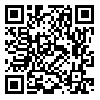Volume 5, Issue 18 (2012)
LCQ 2012, 5(18): 160-180 |
Back to browse issues page
Download citation:
BibTeX | RIS | EndNote | Medlars | ProCite | Reference Manager | RefWorks
Send citation to:



BibTeX | RIS | EndNote | Medlars | ProCite | Reference Manager | RefWorks
Send citation to:
Nojoumian, A A. Textual Love: The Experience of Love in Mostafa Mastour’s
Love on the Sidewalk. LCQ 2012; 5 (18) :160-180
URL: http://lcq.modares.ac.ir/article-29-2944-en.html
URL: http://lcq.modares.ac.ir/article-29-2944-en.html
Shahid Behesthi university
Abstract: (9480 Views)
The present research examines the concept of love in two separate and distinct spheres. On the one hand, love is considered as a transcendental experience and concept that is static and related to a meta-human truth. This type of reading of love is mainly initiated and developed through Plato’s writings. On the other, there is a view that considers love (even in its Platonic sense) a humane, cultural and more importantly “textual” phenomenon. In other words, love can only be understood, multiplied and experienced within language (or as Jacques Lacan calls, “symbolic order”). In this paper, I have studied these two views in relation to the collection of short stories entitled, Love on the Sidewalk, written by the contemporary Iranian writer, Mostafa Mastour. In order to do this, I have first studied the concept of ‘absence’ in love and how the experience of love always depends on the absence of the lover or the beloved. I then argue that love, in these stories, is a ‘sign’ that is constructed and signified with a system of signs. And finally I illustrate how the characters in these stories fall in love and understand love through “narratives of love”. All this would give love a plural and narrative significance. Love is therefore a sign that is always in the process of being constructed.
Received: 2012/02/7 | Accepted: 2012/08/12 | Published: 2012/09/12
| Rights and permissions | |
 |
This work is licensed under a Creative Commons Attribution-NonCommercial 4.0 International License. |








